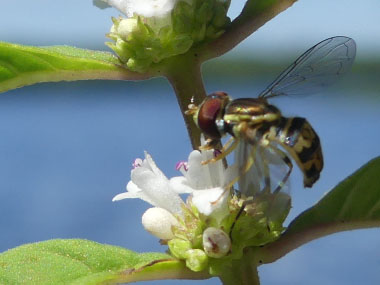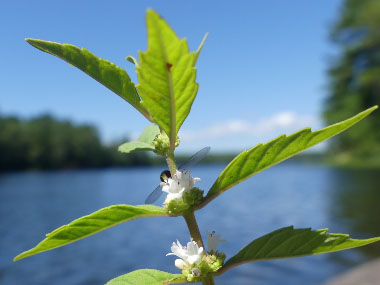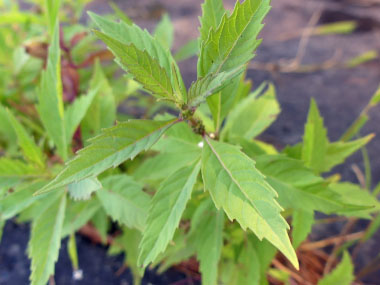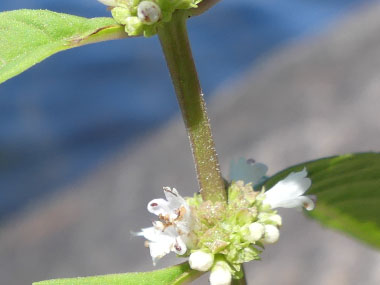






To support our efforts please browse our store (books with health benefits, etc.).
Northern bugleweed is a native, perennial plant in the mint family (Lamiaceae). The genus Lycopus is derived from two Greek words, lykŏs, meaning wolf, and pŏus means foot. The species name, uniflorus, is derived from uni and florus which means one-flowered. Bugleweed comes from the shape of the flower. There are many species in the Lycopus genera so proper identification can be tricky. Northern Bugleweed is most easily distinguished by its short calyx, relative hairlessness, and coarsely toothed but unlobed leaves. The calyx lobes do not extend past the fruits. Other species that may be mistaken for this native include: Lycopus americanus (American Water-horehound), Lycopus asper (Rough Bugleweed), Lycopus europaeus (European Bugleweed), and Lycopus virginicus (Virginia Bugleweed). This is a plant with an interesting history as herbal medicine and as food. Often over-looked as a wild edible, this plant was used as a source of food for many First Nations.
Distinguishing Features
This is a semi-erect, perennial plant that has square stems that can reach to 1 metre (3') tall. They may be sparingly branched or un-branched, with sparse hair or none at all. There is a vertical groove on each side of the stem. Stems are somewhat weak but will sprawl without adjacent plant support. Leaves are opposite and pointed.
Flowers
A small dense cluster of 3mm (1/8") white flowers surround leaf axils along much of the plant. Flowers bloom anytime from July to September depending on geographic location. Usually the flowers in one cluster are not all open at the same time. Each flower is tubular with four spreading lobes of approximately equal size; sometimes the upper lobe is 2-parted or notched. 2 purple-tipped stamens extend out of the tube. Five broadly triangular lobes form the calyx; the calyx is sharply pointed at the tips and are shorter than the floral tube.
 Fields
of Nutrition has medicinal benefits and vitamin/mineral content of Northern Bugleweed.
Fields
of Nutrition has medicinal benefits and vitamin/mineral content of Northern Bugleweed.
Leaves
Leaves can grow to 7.5cm (3") long and 2.5cm (1") wide. They are hairless or minutely hairy and the margins are coarsely toothed. They are generally lance-elliptic to broadly elliptic, pointed at the tip, wedge-shaped at the base, and have a short petiole. They occur opposite with leaf pairs at right angles to the pair above and below. Typically there are 5 to 7 large teeth along each side of a leaf. The upper leaf surface is medium to dark green, while the lower surface is pale. Sometimes, the leaves become purplish green in bright sunlight.
Height
This perennial plant grows anywhere from 10 to 100 cm (4" to 3') tall and is unbranched. The stem is light green, square, and glabrous to short-pubescent.
Habitat
Although this is a more northern distributed plant in North America, it does grow in many central and southern states as well. Habitats include marshes, fens, low areas along pools of water, streambanks, and swamps. Northern bugleweed also grows in other low grounds that are wet to wet-mesic with full to partial sun.
Edible Parts
Leaves are not considered much as food as they are bitter, but are edible. They have a faint mint-like scent. They can be used in salads and in casseroles, stews, etc. Young shoots are reported to be edible as well. Roots can be eaten raw or cooked. The crisp white tubers can be eaten raw in salads or cooked in soups. Roots and tubers can be roasted, although the tubers are not usually substantial in size. They can be pickled.
Other Name
Northern Water-Horehound.
Similar Plants
American Water-Hhorehound, Virginia Bugleweed.
Winter Survival Food Handbook

PDF Plant Magazines
Types of Wild Food
Geographic Zones Seasons
Disclaimer
EdibleWildFood.com is informational in nature. While we strive to be 100% accurate, it is solely up to the reader to ensure proper plant identification. Some wild plants are poisonous or can have serious adverse health effects.
We are not health professionals, medical doctors, nor are we nutritionists. It is up to the reader to verify nutritional information and health benefits with qualified professionals for all edible plants listed in this web site. Please click here for more information.
Why Edible Wild Food?
- Food costs are rising
- Free, wild food is readily abundant
- Wild food adds nutrition to your diet
- Wild food can help treat various medical conditions





